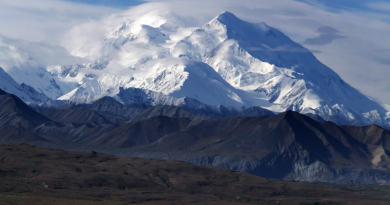Arctic Alaska lakes icing up later, thawing earlier

Small lakes and ponds around Alaska’s North Slope are freezing up later in the year, thawing out earlier in the spring and have ice that is thinner than in past decades, a change attributed to a steadily warming climate in the area, according to a new study led by University of Ottawa scientists.
Long-term monitoring and weather modeling shows that annual ice coverage on hundreds of shallow lakes near Barrow shrank by 24 days a year between 1950 and 2011, the result of a gradual — though fluctuating — warm-up over six decades, said the study, published in the Jan. 30 issue of scientific journal The Cryosphere. Freeze-up is occurring an average 5.9 days later and spring break-up is coming 17.7 to 18.6 days earlier, the study said. When there is ice, it is more likely to be in the form of broken pieces floating on the lake surfaces, the study said. From 1991 to 2011, the fraction of ice in the study area that was still frozen all the way down to lake beds in April decreased by 22 percent.
The 402 Barrow-area lakes considered in the study are shallow — not more than three meters deep — and small, some of them more like ponds, said co-author Cristina Surdu of the University of Ottawa. Most of those lakes are unnamed, she said.
Because of their small size, the lakes’ changes over the past decades have happened under the radar — almost literally. Satellite-based technology used to measure the thickness of Arctic sea ice yields data that is too coarse to catch the gradual transformation in these small lakes, Surdu said.
To measure ice conditions over time at these sites, the study team used other methods — analysis of synthetic aperture radar data collected between 1991 and 2011 — to detect levels of liquid water, and models that factored temperature, precipitation and known lake-ice responses.
The ice shrinkage correlates to a documented increase in mean air temperatures, which trended up by 5.2 degrees Fahrenheit over the six-decade study period. The heat-up in the Barrow area has been dramatic in recent years, taking “an abrupt turn” during the first decade of the 21st century, when mean air temperatures rose by 2.16 degrees, the study said.
Weather so far this winter in Barrow has been within that observed pattern, though Surdu cautions that short-term temperature fluctuations can be just part of the year-to-year weather variability.
Average daily temperatures in Barrow from October through the end of January soared well above the norm for the 1981-2010 time period, according to the National Weather Service’s Alaska database, by 7.5 degrees in October, 6.8 degrees in November, 5.3 degrees in December, and 7.2 degrees in January.
Air temperature is not the only factor affecting lake ice, Surdu said. Snow acts as an insulator for the lakes, and snow coverage has increased over the six-decade study period, she said. “Without the snow, the ice would grow faster or thicker,” she said.
Mixed implications
The findings have mixed implications.
Reduced lake ice, the result of warming, is likely to beget more warming, with solar heat absorbed by dark lake surfaces. There are also concerns about vulnerability of the permafrost below lakes — and possible releases of methane from thawed permafrost, another factor reinforcing the warming trend, Surdu said.
People who use lakes for travel might be put at more risk, facing shortened travel seasons on thinner surfaces, she added.
But local residents and industrial users might benefit from having more fresh water readily available from the lakes, the study says. And impacts on ecosystems are yet to be determined, it says. Warming lake water “may lead to extinction, blooming or migration of various biological species,” the study says.
While lakes around Barrow are getting more watery, some lakes farther south are drying out, another study says.
Some subarctic lakes in flat tundra areas near Old Crow in Canada’s Yukon Territory and in the Hudson Bay area of Manitoba nearly dried out completely in the summer of 2010, which followed a low-snow winter, said the study, published in the Dec. 16 issue of Geophysical Research Letters.
That year may have had drier conditions than any in the prior two centuries, said the study, conducted by scientists at four Canadian universities.
But there are indications of continued dry conditions, said the study’s lead authors. “It looks like last summer was another year of very dry conditions in the lakes,” said Frederic Bouchard with Universite Laval in Quebec.
This drying out, it if continues, threatens wildlife, he said. “For sure, there’s going to be biological or ecosystem effects,” Bouchard said. “These lakes are habitat for many wildlife species” — like geese and other waterfowl, foxes and even polar bears, he said.
If there is vegetation around lakes to catch accumulations of snow, that tends to protect the water bodies from summer drying, Bouchard said. Soil conditions are also important factors, he said.
The researchers plan to examine sediment cores to reconstruct weather and lake conditions in the past several centuries and to see if such dry conditions occurred then, he said.
Contact Yereth Rosen at yereth(at)alaskadispatch.com
Canada: Drilling waste thawing and leaching into lakes in Canada’s Far North, Radio Canada International
Finland:Lake levels rise in Finland, Yle News
United States:Ice-road construction reaches new levels in Arctic Alaska, Alaska Dispatch



